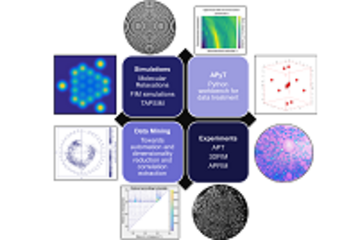All genres
101.
Talk
Materials Simulation: Mechanisms and Processes. BMBF Wing Conference, Dresden, Germany (2015)
102.
Talk
Lath martensite plasticity: A micro-strain mapping study coupled to 3D microstructure characterization. TMS 2015 144th Annual Meeting & Exhibition, Orlando, FL, USA (2015)
103.
Talk
Overcoming challenges in damage engineering: Design of reliable damage quantification methodologies and damage-resistant microstructures. TMS 2015, Orlando, FL, USA (2015)
104.
Talk
Coupled high-resolution experiments and crystal plasticity simulations to analyze stress and strain partitioning in multi-phase alloys. TMS2015, Orlando, FL, USA (2015)
105.
Talk
A novel, high-resolution approach for concurrent mapping of micro-strain and micro-structure evolution up to damage nucleation. TMS 2015, Orlando, FL, USA (2015)
106.
Talk
Experiments on and Simulation of Dual Phase Steel Micromechanics. DGM AK Mikrostrukturmechanik, Kassel, Germany (2015)
107.
Talk
Lath martensite transformation, µ-plasticity and tempering reactions: potential TEM aids. Seminar at Institute of Nanotechnology (INT), Karlsruhe Institute of Technology (KIT), Karlsruhe, Germany (2015)
108.
Talk
Auf dem Weg zu selbstheilenden Stählen:Herausforderungen und potenzielle Strategien. StahlMarkt 2015, Düsseldorf, Germany (2015)
109.
Talk
Experimental and Numerical Investigations on Dual Phase Steel Micromechanics. GLADD-Meeting, Leuven, Belgium (2015)
110.
Talk
Doing more, with less, for longer:Designing high-performance eco-friendly materials guided by in-situ experiments and simulations. Invited Seminar at the Dept. of Mat. Sci. and Eng. of MIT, Boston, MA, USA (2015)
111.
Talk
Micro-mechanically-guided alloy design. Seminat at NIMS, Tsukuba, Japan (2015)
112.
Talk
Micro-mechanically-guided alloy design. Inited Seminar at the Dept. of Mech. Eng. of Kyushu University, Fukuoka, Japan (2015)
113.
Talk
Investigating Stress - Strain Partitioning in Nanostructured Multi-phase Alloys by Coupled Experiments and Simulations. 3rd World Congress on Integrated Computational Materials Engineering, Colorado Springs, CO, USA (2015)
114.
Talk
Doing more, with less, for longer: Designing high-performance eco-friendly materials guided by in-situ experiments and simulations. Invited Seminar at the Dept. of Mat. Sci. and Eng. of MIT, Boston, MA, USA (2015)
115.
Talk
In-situ characterization of martensite plasticity by high resolution microstructure and strain mapping. ICM12, Karlsruhe, Germany (2015)
116.
Talk
A Virtual Laboratory to Derive Mechanical Properties. M2i Conference "High Tech Materials: your world - our business"
, Sint Michielgestel, The Netherlands (2014)
117.
Talk
Joint Multiscale simulation and experimental analysis of stress and strain partitioning in dual phase steel. MRS Fall Meeting , Boston, MA, USA (2014)
118.
Talk
Experimental and simulation analysis of dual phase steel micromechanics. Seminar at Departments of Engineering and Materials, Oxford University, Oxford, UK (2014)
119.
Talk
High-strength steels with improved ductility - potentials for lightweight engineering. Jahrestagung STAHL 2014 – Annual Conference of the German Iron Steel Institute, Düsseldorf, Germany (2014)
120.
Talk
Novel micro-mechanical strategies to unravel complex behavior of multi-phase alloys. JFE Steel Corporation, Tokyo, Japan (2014)











